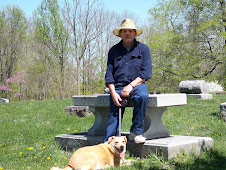


For a few years I've driven by this cemetery, the Old Milan Cemetery (think the movie "Hoosiers"), but have been unable to stop, mostly because there is no place to park a car. The cemetery is divided into three sections. The section this stone is in, jump over a small creek and your in a newer section, while across the road on a little hill is another section, which I never noticed until I went by on my bicycle.
This past weekend I was camping near there and decided to ride my bicycle the 12 miles to the cemetery. At least then I would have a place to park as I could just carry the bicycle into the cemetery.
The stone pictured has always interested me as I drove by because of the carvings, at last I got a chance to get up close to it and look at it carefully.
It is the stone of two sisters, Almyra (20) and Minerva (22) who died within 4 hours of each other. What the cause was I don't know, perhaps typhoid, cholera or any number of causes.
What attracted me to the stone to start with is the carvings. Look at the lady on the left, her right arm (holding a cup/bowl), if you look close, the lower arm is not connected with the rest of the carving. It is one of the best carvings I have ever seen in this area. It looks like it was done recently and not 172 years ago.
Not only is the carving good but the lettering is readable all the way to the bottom where the carver signed his name (he was from Lawrenceburg IN). As I sat there looking at the stone I wondered how long it would have taken him to carve this piece of artwork, who decided what was to be on the stone (picture) and how much it cost.
There's also a lot of symbolism within the caring. I have to assume the lady on the right is the mother of the two girls. We have the urn, the tomb, and either two cherubs or the girls themselves ascending into heaven.
The grave just to the left of this one is another family member, while his stone is not as elaborate it is also well preserved.




Greetings
ReplyDeleteI saw this posting last night and thought I might add some insights to the relief.
This is a composition of previous existing examples used as a grave markers.
The “mother” is used to depict the mother of all mothers, mother “earth” and represents the result of creation, She is in a posture of grief. Her dress is that of a girdle and belt to depict he grief is both heartfelt and is worn as a girth around the waist as in wearing her pain .
The Urn is used through the ages to depict the vital organs buried. It also represents a vessel containing tears of grief. The urn is adorned by feathers which whenever is used depicts the soul/spirit in flight –making a return journey whence it had once came from.
Her right hand holds a container/vessel of sorts. What this symbolizes is that it represents, in symbolic form, her womb. The manner in which she holds it means that the fruits of her womb has been emptied out. Notice the manner in which it is used as being poured out. Any vessel/container held at that angle can no longer contain anything, meaning her grief is being poured out.
The boxlike vessel is rather interesting and I suspect that it may contain the cremains (ashes) of a loved one lie for example the mother or parents themselves, which is the done thing if the parents die in the vicinity of where there children are buried, since parents whose offspring have been buried, rarely leave this place for long.
The Clouds represents the heavens above and also the “heaven” of Christians.
The Angels are not the two daughters being represented as angelic beings, but rather, these to winged effigies represent the children’s Guardian Angels. This type of effigies also represent the soul in flight. Interesting to note is the one visible flamed torch. Usually these are seen turn upside down, representing death, however in this picture it is held upright meaning that there is victory in life and life everlasting.